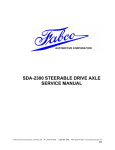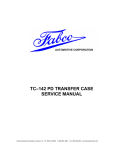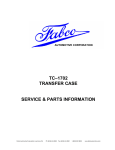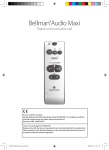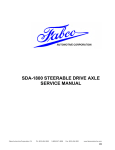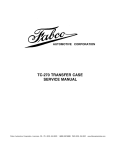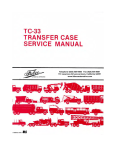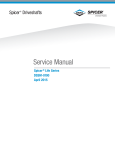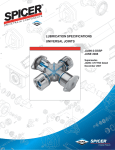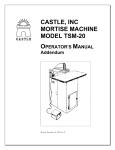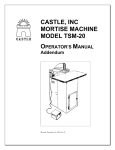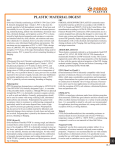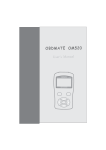Download TC-28 Service Manual - Fabco Automotive Corporation
Transcript
Service Manual Transfer Case – Model TC 28 625‐0560 Revision A Table of Contents MODEL TC‐28, TRANSFER CASE 1.0 Introduction 1.1 Assembly Views 1.2 LUBRICATION 2.0 Recommended Lubricants 2.1 Inspection 2.2 Oil Change 2.3 Draining the Oil 2.4 Refilling the Oil 2.5 Operating Temperature 2.6 CLEANING AND INSPECTION 3.0 Cleaning 3.1 Drying and Corrosion Inhibition 3.2 Inspection 3.3 GENERAL INSTRUCTIONS 4.0 Safety 4.1 Assembly Precautions 4.2 Removal 4.3 Installation 4.4 Fabco Automotive Corporation – Model TC 28 Transfer Case Service Manual Page | 2 625‐0560 Rev. A (Issued 02‐01‐13, Modified 04‐24‐13) Table of Contents DISASSEMBLY 5.0 Preliminary Steps 5.1 Shift Component Removal 5.2 Input Shaft Removal 5.3 Intermediate Shaft Removal 5.4 Rear Axle Output Shaft Removal 5.5 Front Axle Output Shaft Removal 5.6 ASSEMBLY 6.0 General Precautions 6.1 Clutch Gear and Bearing Assemblies 6.2 Rear Axle Output Shaft Installation 6.3 Front Axle Output Shaft Installation 6.4 Intermediate Shaft Installation 6.5 Input Shaft Installation 6.6 Electric Shifter Installation 6.7 Electric Shifter Configuration 6.8 Front Engagement 6.8.1 High/Low Engagement 6.8.2 Troubleshooting 6.8.3 Final Assembly 6.9 TORQUE SPECIFICATIONS 7.0 SEAL INSTALLATION PROCEDURE 8.0 NOTE: When ordering parts, specify model number, part number, serial number or other information that is on the Fabco nameplate located on the Transfer Case housing. Part numbers contained in this manual were in effect at the time the manual was approved for printing and are subject to change without notice or liability. Fabco Automotive Corporation reserves the right to change parts at any time. Fabco Automotive Corporation – Model TC 28 Transfer Case Service Manual Page | 3 625‐0560 Rev. A (Issued 02‐01‐13, Modified 04‐24‐13) Model TC‐28, Transfer Case 1.0 1.1 Introduction Fabco Transfer Case Specification Model T‐28 The TC‐28 Transfer Case is a two‐speed, four‐shaft, constant mesh design featuring a declutch mechanism for front axle and underdrive engagement. Ratings – Nominal Torque 3,600 Lb. Ft. Horsepower 300 Input Speed 4,000 RPM Ratio 1:1 High Range, 2.2:1 Low Range Gear Type Ground Spur and Helical Gears Shaft Sizes SPL90/100 Input and Rear Output SPL55 Front Output Housing Construction Cast Iron Shaft Spacing (Drop) 8.50‐Inches Shift Mechanisms Electric Actuators Bearings Tapered Roller Bearings Lubrication System Splash Lubricant Specification SAE 50W Synthetic Oil Lubricant Capacity ‐ Nominal 7 Quarts Weight ‐ Dry 350‐lbs Fabco Automotive Corporation – Model TC 28 Transfer Case Service Manual Page | 4 625‐0560 Rev. A (Issued 02‐01‐13, Modified 04‐24‐13) 1.2 Assembly Views Fabco Automotive Corporation – Model TC 28 Transfer Case Service Manual Page | 5 625‐0560 Rev. A (Issued 02‐01‐13, Modified 04‐24‐13) Lubrication 2.0 2.1 Recommended Lubricants SAE 50 synthetic is recommended for on/off‐highway operation. NOTE: EXTREME PRESSURE (EP) OILS ARE NO LONGER RECOMMENDED FOR USE IN FABCO TRANSFER CASES. UNDER CERTAIN OPERATING CONDITIONS THESE OILS MIGHT FORM CARBON DEPOSITS ON GEARS AND SHAFTS. 2.2 Inspection The oil is to be maintained at the level of the fill plug at all times. Check at the following intervals: Highway Service …………..………...1,000 Miles Off‐Highway Service …….……..……....40 Hours 2.3 Oil Change The transfer case lubricant should be changed on all new transfer cases after the first 3,000 to 5,000 miles (on‐highway), or the first 40 hours (off‐highway); thereafter oil changes should be done at the following intervals: On‐Highway Service……...10,000‐15,000 Miles Off‐Highway Service…………........500‐700 Hours The recommended oil change and inspection periods are based on average use and operating conditions that the unit may encounter. It is suggested that the individual owner make a periodic lab analysis of the lubricant to determine contamination based on the units specific operating conditions. With this data, the oil change and inspection periods can be better determined. 2.4 Draining the Oil Draining is best accomplished after the vehicle has been operated briefly, allowing the oil to become warm and flow more freely. Remove both drain and fill plugs. Allow the housing to empty completely. Before the unit is refilled, it should be thoroughly flushed with clean flushing oil or kerosene. 2.5 Refilling the Oil If the transfer case has been removed from the vehicle for service, it is the best to refill the oil after the unit has been reinstalled into the vehicle. Clean and replace the drain plug and fill the transfer case with the appropriate oil with the vehicle on level ground. Fill the transfer case to the level of the oil fill plug located on the front, see 1.2 Assembly Views. Fabco Automotive Corporation – Model TC 28 Transfer Case Service Manual Page | 6 625‐0560 Rev. A (Issued 02‐01‐13, Modified 04‐24‐13) 2.6 Operating Temperature The operating temperature of the transfer case should not exceed 250°F (120°C). Extensive operation at temperatures exceeding 250°F will result in rapid brake down of the oil and may shorten the transfer case life. The following conditions may contribute to excessive oil temperatures: 1. A vehicle which is used in tropical or desert conditions. 2. A vehicle where extended body work or an accumulation of dirt and plant material may shield the case from air ventilation and circulation. A vehicle that is operated for extended distances at high speed with the main transmission in overdrive. Fabco Automotive Corporation – Model TC 28 Transfer Case Service Manual Page | 7 625‐0560 Rev. A (Issued 02‐01‐13, Modified 04‐24‐13) Cleaning and Inspection 3.0 3.1 Cleaning Steam may be used for external cleaning of completely assembled units. Care must be taken to ensure that water is kept out of the assembly by sealing breather caps and other openings. The transfer case housing which, is too large to conveniently clean with solvents, may be immersed in a hot solution tank containing a mild alkaline solution. Parts clean in a hot solution tank must be rinsed thoroughly to prevent damage by traces of alkaline material. Parts with ground or polished surfaces, such as bearings, gears, and shafts should be clean with emulsion cleaners or petroleum solvents. An alkaline solution may damage the machined surfaces and such cleaning methods should be avoided. 3.2 Drying and Corrosion Inhibition Dry compressed air or clean, soft shop towels should be used to dry parts after cleaning. Bearings should never be spun dry with compressed air. Dried parts should be immediately coated with a light oil or corrosion inhibitor to prevent corrosion damage. Parts which are to be stored should also be wrapped in heavy waxed paper or plastic bags and kept dust‐free. 3.3 Inspection Prior to reassembly, parts which are to be reused must be carefully inspected for signs of wear or damage. Replacement of such parts can prevent costly downtime at a future date. All bearing surfaces, including roller bearings cups and cones, should be examined for pitting, wear, or overheating. Gears may also show pits, as well as scoring and broken teeth. Shafts may be nicked or marked, or have damage threads. Parts which show any signs of damage should be repaired or replaced. Check all shift forks and slots in sliding clutches for wear or discoloration due to heat. Check the engaging teeth for a partial engagement wear pattern. Fabco Automotive Corporation – Model TC 28 Transfer Case Service Manual Page | 8 625‐0560 Rev. A (Issued 02‐01‐13, Modified 04‐24‐13) General Instructions 4.0 4.1 Safety The servicing and maintenance of components from any automotive vehicle present possible hazards, every endeavor should be made to minimize the risk taken to successfully complete the task. For your protection we offer these warnings and suggestions. 1. When working on, around, or under, the vehicle the parking brake should be securely applied and all wheels should be blocked to prevent wheel movement. Do not rely on the vehicle being in gear with a dead engine to prevent movement. All work should be performed on a flat level surface free of loose material. 2. When working under a vehicle, it should be raised and supported with the appropriate frame stands or very secure blocking. WARNING: NEVER WORK UNDER A VECHILE WHILE SUPPORTED ONLY ON A FLOOR JACK OR HOIST. 3. 4. Be sure any lifting equipment has adequate capacity to raise the vehicle or component being lifted. This includes hydraulic floor jacks, and axle support dollies, etc. The weight of Fabco components is given in the front of the applicable service manual. Caution must be exercised when cleaning the component or underside of the vehicle. Compressed air should not be used to blow dirt away as any harmful contaminant material on the bottom of the vehicle will be spread around the work area. Appropriate solvents and cleaning solutions can be used in accordance with their labeling instructions or by referring to the Material Safety Data Sheet (MSDS) that is available for each cleaner. Approved protective eyewear, gloves, masks, and clothing should always be worn. 4.2 Assembly Precautions 1. Read these instructions completely before starting reassemble. Refer to the appropriate exploded view in the parts manual. 2. All parts must be cleaned. The gasket surfaces must be free of oil gasket material. Do not reuse old gaskets. 3. Bearing cups bores, shaft splines and bearing mounting surface, should be coated with recommended Transfer Case lubricant. This is necessary to reduce the possibility of galling. 4. All used oil seals must be replaced and the new oil seals. The sealing lips should be coated with recommended Transfer Case lubricant to provide initial lubrication. 5. All external cap screws should have three threads coated with high strength thread locker prior to final installation. Fabco Automotive Corporation – Model TC 28 Transfer Case Service Manual Page | 9 625‐0560 Rev. A (Issued 02‐01‐13, Modified 04‐24‐13) 6. All threaded fasteners should be tightened to the torque specified in the torque specification section. 7. Any sharp edges on the seal diameter of the universal joint yoke or companion flanges should be removed with emery cloth and should be coated with recommended Transfer Case lubricant on the seal operating area prior to installation. 8. In many of the procedures, when a part is assembled with a press fit, it is recommended that the part be heated prior to installation. The part should be placed in an oven and heated to no more than 300°F. Excessive heat my change the metallurgical properties of the part. Heated components should be allowed to cool to room temperature before end float measurements are made. CAUTION: ALTHOUGH FABCO DOES NOT RECOMMEND ITS USE IN TRANSFER CASES, IF FORMED‐IN‐ PLACE GASKET IS USED FOR REPAIRS. EXTREME CAUTION MUST BE EXERCISED TO PREVENT THE COMPOUND FROM ENTERING BEARINGS, OIL GALLERIES, AND PASSAGES OR TAPPED HOLES. ALL BEADS MUST BE KEPT SMALLER THAN 1/8 INCH DIAMETER. 4.3 Removal 1. Remove the fill and lower drain plugs and drain gear lubricant. 2. Disconnect and tag the electrical harness main connector, on the Transfer Case, from the electrical harness on the vehicle frame. 3. Disconnect the drivelines at flanges or yokes. 4. Since mounting designs vary by vehicle configuration, consult the vehicle service manual on the proper Transfer Case removal procedure. 5. After the Transfer Case is removed from the vehicle, remove and tag all external mounting brackets. 6. Disconnect and tag the electrical harness connectors from the electrical actuators and switches. 4.4 Installation 1. Connect the electrical harness connectors from the electrical actuators and switches. 2. Connect the Transfer Case mounting. 3. Since mounting designs vary, consult vehicle service manual on proper Transfer Case installation onto the vehicle. 4. Connect the drivelines, and the electric harness main connector to the electrical connector located on the body of the vehicle. 5. Fill the housing with the appropriate lubrication to the correct level and install the oil fill plug. Fabco Automotive Corporation – Model TC 28 Transfer Case Service Manual Page | 10 625‐0560 Rev. A (Issued 02‐01‐13, Modified 04‐24‐13) 6. Road test the vehicle and check the Transfer Case for leaks around seals and gaskets. 7. After the road test, recheck the oil level and the Transfer Case for leaks around the seals and gaskets. Fabco Automotive Corporation – Model TC 28 Transfer Case Service Manual Page | 11 625‐0560 Rev. A (Issued 02‐01‐13, Modified 04‐24‐13) Disassembly 5.0 As parts are removed from the Transfer Case, tag each part with location and mark to indicate position and orientation thereby simplifying installation during assembly. NOTE: REMOVE THE BEARING CUPS FROM THEIR GEARS ONLY IF REPLACING THEM. 5.1 Preliminary Steps 1. After removing the Transfer Case from the vehicle, thoroughly clean the exterior. 2. Remove the drain plug and drain the oil. 3. Mount the Transfer Case in a suitable fixture. 4. Remove the yoke nuts, take off all yokes, and yoke spacers. 5. Remove all seal carriers, bearing caps, bearing cap spacers, gaskets, and internal shims, except the rear intermediate cap. 5.2 Shift Component Removal 1. Remove the electric harness. 2. Remove all of the remaining plugs from the Transfer Case. 3. Remove the electric motors, and motor plate adapters. 4. Remove the cover plate, and cover plate gasket. 5. Remove the switches, shim washers, and dowel pins from the top of the Transfer Case. Fabco Automotive Corporation – Model TC 28 Transfer Case Service Manual Page | 12 625‐0560 Rev. A (Issued 02‐01‐13, Modified 04‐24‐13) 6. Cut and remove the safety wire from the set screws located on the shift forks. 7. Remove the set screws from the shift fork. 8. Rotate the shifter shaft assemblies 180 degrees; the slots on the shifter shafts should be oriented in the opposite direction. 9. Using a set of pliers, compress the spring located on the shift forks, and remove the spring retainer caps. 10. Remove the shifter shaft assemblies from the Transfer Case by pushing on the shafts from the front to the rear. 11. Remove the front axle engagement fork with the spring. Fabco Automotive Corporation – Model TC 28 Transfer Case Service Manual Page | 13 625‐0560 Rev. A (Issued 02‐01‐13, Modified 04‐24‐13) 5.3 Input Shaft Removal 1. Engage the clutch gear into the direct drive gear; restrain low drive gear by placing a wood block in‐between the low drive gear and the housing interior (rear). 2. Drive the input shaft from the front to the rear, exposing the ring underneath the low drive gear. 3. Remove block and remove the ring. 4. Drive the shaft from the rear to the front, pushing the shaft out the front of the Transfer Case. Catch the bearing cones and spacers as they come off the shaft. 5. Remove the high low shift fork with the spring. 6. Remove the remaining loose parts form the Transfer Case interior. Fabco Automotive Corporation – Model TC 28 Transfer Case Service Manual Page | 14 625‐0560 Rev. A (Issued 02‐01‐13, Modified 04‐24‐13) 5.4 Intermediate Shaft Removal 1. Remove the rear intermediate bearing cap, and gasket. 2. Engage the clutch gear into the underdrive gear. 3. Place a block in‐between the clutch gear and the rear of the Transfer Case housing. 4. Drive the shaft and direct drive gear out the back of the Transfer Case housing. 5. Catch the bearing cones and spacers as they come off the shaft. 6. Remove remaining loose parts from the Transfer Case interior. 5.5 Rear Axle Output Shaft Removal 1. Push the shaft out the front of the case and out of the gear, catching the bearing and spacers. 5.6 Front Axle Output Shaft Removal 1. Follow procedure outlined under section 5.3, except for items 2 and 3. Fabco Automotive Corporation – Model TC 28 Transfer Case Service Manual Page | 15 625‐0560 Rev. A (Issued 02‐01‐13, Modified 04‐24‐13) Assembly 6.0 6.1 General Precautions 1. Read these instructions completely before starting reassembly. Refer to the appropriate exploded view in the parts manual, 625‐0551. Assemble, adjust and check in the order shown. 2. Parts must be clean. Gasket surfaces must be free of old gasket material. 3. Select a work area that will maintain the cleanliness of the parts and the assembly. Mount the Transfer Case housing with the cover on top. The cover side, the front and rear of the case should be accessible. The housing must be restrained. A sturdy work bench or special stand should be used. The components of this are heavy and positioning and installing them will be easier if the Transfer Case is supported in the position indicated. 4. Lubricate housing bores, shaft splines and bearing mounting surfaces, sealing lips on oil seals with recommended Transfer Case lubricant. This is necessary to reduce the chances of galling or scoring and to provide initial lubrication for the oil seals. 5. Installation of gaskets, bearing carriers, seal carriers and caps will be simplified if two temporary guide studs are utilized. 6. Universal joint yokes or companion flanges should be coated with recommend Transfer Case lubrication on the seal operating area before installation. They should be tightened into place with the locknuts tightened to the proper final torque shown in section 7.0. 7. Seals supplied by Fabco are coated on the outside and should not be coated with Permatex before installation in their carriers. They should be coated on the sealing lip with recommend Transfer Case lubrication. 8. Use high strength thread locker or equal pliable setting sealant on bolt threads. If bolt threads are not sealed they will leak oil. 9. All bolts and nuts should be tightened to torque indicated on torque chart in section 7.0. 10. Allow heated components to cool to room temperature before making bearing adjustments. 6.2 Clutch Gear and Bearing Assemblies 1. A light coat of recommend Transfer Case lubrication should be applied to the bore of the gear before pressing the cups into place. 2. Check the end play as follows: a. Match the gear with the shaft. Slip a clutch onto the shaft (to aid in disassembling). Slide a bearing cone onto the shaft followed by a spacer. Put the gear into place and then the second bearing cone. Using a press, clamp the bearing‐spacer‐bearing assembly in place utilizing a temporary spacer tube between the second bearing cones. Fabco Automotive Corporation – Model TC 28 Transfer Case Service Manual Page | 16 625‐0560 Rev. A (Issued 02‐01‐13, Modified 04‐24‐13) b. The axial end play between the gear and the shaft should now be between .001” and .005”. If not, change the spacer between bearing cones. 6.3 Rear Axle Output Shaft Installation 1. Press rear bearing cup into the Transfer Case housing. 2. Install split retaining ring on the rear output shaft. 3. Heat the front bearing cone to approximately 250°F. Press front bearing cone onto the rear output shaft. 4. Heat the rear bearing cone to approximately 250°F. Place rear bearing cone and direct drive gear towards the rear of the Transfer Case housing at the rear output location. 5. Drive the rear output shaft assembly (shaft, ring, and bearing cone) through the front of the housing, direct drive gear, front bearing cone, and out the rear. 6. Install the front bearing cup. Fabco Automotive Corporation – Model TC 28 Transfer Case Service Manual Page | 17 625‐0560 Rev. A (Issued 02‐01‐13, Modified 04‐24‐13) 7. Temporarily install the shim stack, spacer, gasket and cap. Tighten the mounting bolts to approximately 25 lb. ft. of torque. Install, yoke spacer, yoke, and yoke nut. Torque yoke nut to torque, shown in section 7.0. 8. Check rear output shaft end float between the shaft and housing. End float should be between .001” and .005”. If end float is within range, skip to Item 10. 9. If end float is below this range remove the necessary shims. If end float is above this range add the necessary shims to obtain a measured value between .001” to .005”. Remove all installed components from Item 7, add or remove the necessary shims, and repeat Items 7‐8. 10. Tighten the mounting bolts to final torque, shown in section 7.0. 11. Install seal, yoke spacer, yoke, and yoke nut. Torque yoke nut to final torque, shown in section 7.0. Fabco Automotive Corporation – Model TC 28 Transfer Case Service Manual Page | 18 625‐0560 Rev. A (Issued 02‐01‐13, Modified 04‐24‐13) 6.4 Front Axle Output Shaft Installation 1. Heat the front bearing cone to approximately 250°F. Press the front bearing cone on the front output shaft. 2. Place the direct drive gear assembly containing the direct drive gear, bearing cups (gear), bearing cone (gear front side), and clutched gear engaged into the housing and position it on the rear side of the housing. 3. Drive the front output shaft assembly through the front of the housing, through the direct drive gear assembly, and back out the rear. 4. Install the bearing spacer (gear), and the rear bearing cone (gear) onto the front output shaft. 5. Heat the rear bearing cone to approximately 250°F. Press the rear bearing cone on the front output shaft. 6. Install the rear bearing cup, spacer, gasket, and cap assembly. Tighten the mounting bolts to final torque, shown in section 7.0. 7. Install the front bearing cup. Fabco Automotive Corporation – Model TC 28 Transfer Case Service Manual Page | 19 625‐0560 Rev. A (Issued 02‐01‐13, Modified 04‐24‐13) 8. Temporarily install the shim stack, gasket and front output carrier. Temporarily tighten the mounting bolts to approximately 25 lb. ft. of torque. Install, yoke spacer, yoke, and yoke nut. Torque yoke nut to toque, shown in section 7.0. 9. Check front output shaft end float between the shaft and housing. End float should be between .001” and .005”. If end float is within range, skip to Item 11. 10. If end float is below this range remove the necessary shims; if end float is above this range add the necessary shims to obtain a measured value between .001” to .005”. Remove all installed components from Item 7, add or remove the necessary shims, and repeat Items 8‐9. 11. Tighten the mounting bolts to final torque shown in section 7.0. 12. Install seal, yoke spacer, yoke, and yoke nut. Tighten the yoke nut to final torque, shown in section 7.0. 6.5 Intermediate Shaft Installation 1. Press the rear bearing cup into the rear intermediate cap. 2. Assemble the retaining ring and direct drive gear onto the intermediate shaft. Fabco Automotive Corporation – Model TC 28 Transfer Case Service Manual Page | 20 625‐0560 Rev. A (Issued 02‐01‐13, Modified 04‐24‐13) 3. Heat the rear bearing cone to approximately 250°F. Press the rear bearing cone on the intermediate shaft. 4. Assemble the bearing cups (gear), bearing cone (gear rear side) onto the low drive gear. Engage the clutch gear onto the low drive gear. Place the assembly through the top housing cover and position it at the intermediate position towards the front of the housing. 5. Drive the intermediate shaft assembly through the rear of the housing, through the low gear assembly and out the front of the housing. 6. Install the gasket and the rear intermediate cap with rear bearing cup onto the housing. Tighten the mounting bolts to final torque shown in section 7.0. 7. Install the bearing spacer (gear) and front bearing cone on to the intermediate shaft. 8. Heat the front bearing cone to approximately 250°F. Press the front bearing cone on the intermediate shaft. 9. Temporarily install the front bearing cup, shim stack, gasket and front cap. Tighten the mounting bolts to approximately 25 lb. ft. of torque. 10. Check front output shaft end float between the shaft and housing through the 3/8 vent plug provision on the front intermediate cap. End float should be between .001” and .005”. If end float is within range, skip to Item 12. 11. If end float is below this range remove the necessary shims; if end float is above this range add the necessary shims to obtain a measured value between .001” to .005”. Remove all installed components from Item 9, add or remove the necessary shims, and repeat Items 9‐10. 12. Tighten the mounting bolts to final torque, shown in section 7.0. 13. Apply pipe thread sealant to the threads of the breather vent and install on the front intermediate cap. Fabco Automotive Corporation – Model TC 28 Transfer Case Service Manual Page | 21 625‐0560 Rev. A (Issued 02‐01‐13, Modified 04‐24‐13) 6.6 Input Shaft Installation 1. Press bearing cups (gear) into the low drive gear; install the bearing cup (gear rear side) into the low drive gear. 2. Place direct drive gear assembly into the housing at the rear position of the housing. 3. Install the high/low shift fork assembly containing the high/low shift fork, spring, and clutch gear into the housing and engage the clutch gear into the low drive gear. 4. Install the high/low shift shaft assembly containing the high/low shift shaft, high/low cam shaft, thrust washer front, and cam shaft pin, through the housing and shift fork. 5. Place the low drive gear into the housing towards the front of the housing. 6. Drive the input shaft through the front of the housing, through the low drive gear, clutch gear, direct drive gear assembly. 7. Install the retaining ring on the input shaft, and drive the input shaft towards the front of the housing until the ring butts against the low drive gear. 8. Install the bearing spacer (gear), rear bearing cone (gear). Fabco Automotive Corporation – Model TC 28 Transfer Case Service Manual Page | 22 625‐0560 Rev. A (Issued 02‐01‐13, Modified 04‐24‐13) 9. Heat the rear bearing cone to approximately 250°F. Press the rear bearing cone on the Input shaft. 10. Install the rear bearing cup, spacer, gasket and front cap. Tighten the mounting bolts to final torque, shown in section 7.0. 11. Heat the front bearing cone to approximately 250°F. Press the front bearing cone on the input shaft. 12. Temporarily install the front bearing cup, shim stack, gasket and front carrier. Tighten the mounting bolts to approximately 25 lb. ft. of torque. Install yoke spacer, yoke, and yoke nut. Torque yoke nut to torque, shown in section 7.0. 13. Check input shaft end float between the shaft and housing. End float should be between .001” and .005”. If end float is within range, skip to Item 15. 14. If end float is below this range remove the necessary shims; if end float is above this range add the necessary shims to obtain a measured value between .001” to .005”. Remove all installed components from Item 12, add or remove the necessary shims, and repeat Items 12‐13. 15. Tighten the mounting bolts to final torque shown in section 7.0. 16. Install seal, yoke spacer, yoke, and yoke nut. Tighten the yoke nut to final torque, shown in section 7.0. Fabco Automotive Corporation – Model TC 28 Transfer Case Service Manual Page | 23 625‐0560 Rev. A (Issued 02‐01‐13, Modified 04‐24‐13) 6.7 Electric Shifter Installation 1. Install the front engage fork with spring into the housing. 2. Install the front engage shift shaft assembly through the housing and front engagement fork. 3. Rotate the high/low and front engagement shift shafts until the groves in the shaft are facing the opposite direction of the top Transfer Case opening. Compress the spring on the shift fork with a set of pliers and install the spring retaining caps (opening side facing the transfer case opening) on both ends of the spring. 4. Rotate the high/low and front engagement shift shafts until the groves are lined up to the threaded holes on the shift forks. The opening on the spring retaining caps should be pointed towards the opening of the housing. Apply a bead of high strength thread locker to the threads on the screws and install them on the shift forks. Tighten the screws to the final torque shown in section 7.0. 5. Proceed to install safety wire thru the holes on the head of the screws and tighten wire. 6. Install the rear thrust washers and the motor plate adapters. Tighten the motor adapter screws to the final torque shown in section 7.0. Fabco Automotive Corporation – Model TC 28 Transfer Case Service Manual Page | 24 625‐0560 Rev. A (Issued 02‐01‐13, Modified 04‐24‐13) 7. Apply a continuous 1/16” bead of Loctite 515 or equal to the rear of the electric motor and proceed to install the electric shift motors onto the motor plate adapters. Apply a bead of Loctite 272 to the threads of the motor adapter screws and tighten to the final torque shown in section 7.0. Fabco Automotive Corporation – Model TC 28 Transfer Case Service Manual Page | 25 625‐0560 Rev. A (Issued 02‐01‐13, Modified 04‐24‐13) 8. Install the high/low and front engagement indicator pins. 9. Temporally install the switches with two washer shims per switch and tighten to 25 lb. ft. 10. Temporally install the harness to the switches. 6.8 Electric Shifter Configuration 6.8.1 Front Engagement: Switch 1 and 2 control the front output engagement and are both normally closed switches. Check the continuity of switch 1 and 2 to determine if the front output is engaged, disengaged, or semi‐engaged: Switch 1 Switch 2 Status Closed Open Disengaged Open Open Partially engaged Open Closed Fully engaged Fabco Automotive Corporation – Model TC 28 Transfer Case Service Manual Page | 26 625‐0560 Rev. A (Issued 02‐01‐13, Modified 04‐24‐13) Closed Closed Not possible / error a. If disengaged: 1. Apply 12V to wire 3 (NX42+) and connect wire 8 (NX42‐) to ground. (This should engage the front output shaft.) 2. Check switch 1 to confirm that it is open. If closed then remove the switch, add or remove a shim washer and re‐check switch to confirm that is open. 3. Check switch 2 to confirm that it is closed. b. If partially engaged follow same procedure as step 1. c. If engaged: 1. Apply 12V to wire 8 (NX42‐) and connect wire 3(NX42+) to ground. (This should disengage the front output shaft.) 2. Check switch 1 to confirm that it is closed. 3. Check switch 2 to confirm that it is open. If closed then remove the switch, add or remove a shim washer and re‐check switch to confirm that is open. d. Cycle through engagement and disengagement 1‐2 times to confirm proper switch operation. 6.8.2 High/Low Engagement: Switch 3 and 4 control the engagement of high and low gears and are both normally closed switches. Check the continuity of switch 3 and switch 4 to determine if high gear is engaged, low gear is engaged, or either gear is semi engaged. Do this by according to the chart below. Switch 3 Switch 4 Status Closed Open Low engaged Open Open Neutral or high/low partially engaged Open Closed High engaged Closed Closed Not possible / error a. If low is engaged: 1. Apply 12V to wire 7 (NX93+) and connect wire 12 (NX93‐) to ground. (This should engage high gear.) 2. Check switch 3 to confirm that it is open . 3. Check switch 4 to confirm that it is closed. Fabco Automotive Corporation – Model TC 28 Transfer Case Service Manual Page | 27 625‐0560 Rev. A (Issued 02‐01‐13, Modified 04‐24‐13) b. If partially engaged follow same procedure as step 5. c. If high is engaged: 1. Apply 12V to wire 12 (NX93‐) and connect wire 7 (NX93+) to ground. (This should engage low gear.) 2. Check switch 3 to confirm that it is closed. 3. Check switch 4 to confirm that it is open. d. Cycle through engagement and disengagement 1‐2 times to confirm proper switch operation. 6.8.3 Troubleshooting: a. Make sure that the yellow wire on the Front engagement motor is connected to wire 3 (NX42+). b. Make sure that the yellow wire on the high‐low motor is connected to wire 7 (NX93+). c. Remove switch and check functionality with a continuity checker. d. With switch removed, check to see if the dowel pin below the switch can slide freely. 6.9 Final Assembly 1. Rotate all shafts with shift shafts shifted to all positions. Observe through cover opening on the housing, making sure there are no loose tools, bolts or other foreign objects in the assembly. 2. Remove electrical harness. 3. Remove switches and apply pipe thread sealant or equal on threads. Install switches and tighten to final torque shown in section 7.0. 4. Install cover plate gasket, and cover plate. Tighten mounting bolts to final torque shown in section 7.0. 5. Install electrical harness. 6. Install drain plug, and fill Transfer Case with lube. 7. Install the fill and shift shaft cover plugs. 8. Attach all mounting brackets before reinstalling case in the truck. Fabco Automotive Corporation – Model TC 28 Transfer Case Service Manual Page | 28 625‐0560 Rev. A (Issued 02‐01‐13, Modified 04‐24‐13) Torque Specifications 7.0 Fabco Automotive Corporation – Model TC 28 Transfer Case Service Manual Page | 29 625‐0560 Rev. A (Issued 02‐01‐13, Modified 04‐24‐13) Seal Installation Procedure 8.0 1. Drop the driveline to access the yoke retaining nut. 2. Remove the retaining nut from the shaft. See Figure below: 3. Pull the yoke straight off the shaft. Inspect the yoke to verify that it is in good condition. If excessive wear is noted, the yoke should be replaced. If any burrs are found on the seal journal, they should be removed if the yoke is to be reinstalled. NOTE: YOKE SPACER MAY FALL OUT DURING YOKE REMOVAL AND MUST BE INSTALL PIOR TO YOKE REINSTALLATION. 4. Pull the old seal from the carrier. 5. Clean the seal bore in the housing carrier where the old seal had been located. Fabco Automotive Corporation – Model TC 28 Transfer Case Service Manual Page | 30 625‐0560 Rev. A (Issued 02‐01‐13, Modified 04‐24‐13) 6. Inspect the new seal to verify that the lips material is intact and in good condition free of any nicks and marks. Also, check the outside diameter of the new seal for any dents or burrs. If any are found the seal should not be installed. 7. Place the seal on the seal driver tool (866‐0912), shown in the Figure below, ensuring the spring side is facing away from the seal driver tool. 8. Place the seal driver onto the shaft, see Figure below. Drive the seal driver with until the seal driver lip with the machine face of the carrier. Fabco Automotive Corporation – Model TC 28 Transfer Case Service Manual Page | 31 625‐0560 Rev. A (Issued 02‐01‐13, Modified 04‐24‐13) 9. Remove the seal driver. 10. Lubricate the shaft splines, seal lips, and drive yoke seal journal with Transfer Case lubricant. 11. Start the driver yoke on the shaft, ensuring the splines are properly engaged and slide freely. Push the drive yoke onto the shaft until it seats. 12. Check the Dust lip to ensure it is not folded under and is facing out. If the dust lip is folded under, pull out the drive yoke ½ to 1”, rotate and push‐in the drive yoke. Repeat until dust lip is correctly installed. 13. Install the retaining nut and torque to specification. 14. Rotate the drive yoke by hand to check for binding and interference. 15. Check oil and fill as necessary. Fabco Automotive Corporation – Model TC 28 Transfer Case Service Manual Page | 32 625‐0560 Rev. A (Issued 02‐01‐13, Modified 04‐24‐13) Fabco Automotive Corporation – Model TC 28 Transfer Case Service Manual Page | 33 625‐0560 Rev. A (Issued 02‐01‐13, Modified 04‐24‐13) Fabco Automotive Corporation 151 Lawrence Drive Livermore, CA 94551 USA Phone: (925) 454‐9500 Toll‐Free: (800) 967‐8838 Fax: (925) 454‐9501 [email protected] www.FabcoAutomotive.com R. Cushman & Associates 12623 Newburgh Rd Livonia, MI 48150 USA Phone: (248) 477‐9000 Fax: (248) 477‐7883 www.RCushman.com Fabco Automotive Corporation – Model TC 28 Transfer Case Service Manual Page | 34 625‐0560 Rev. A (Issued 02‐01‐13, Modified 04‐24‐13)




































